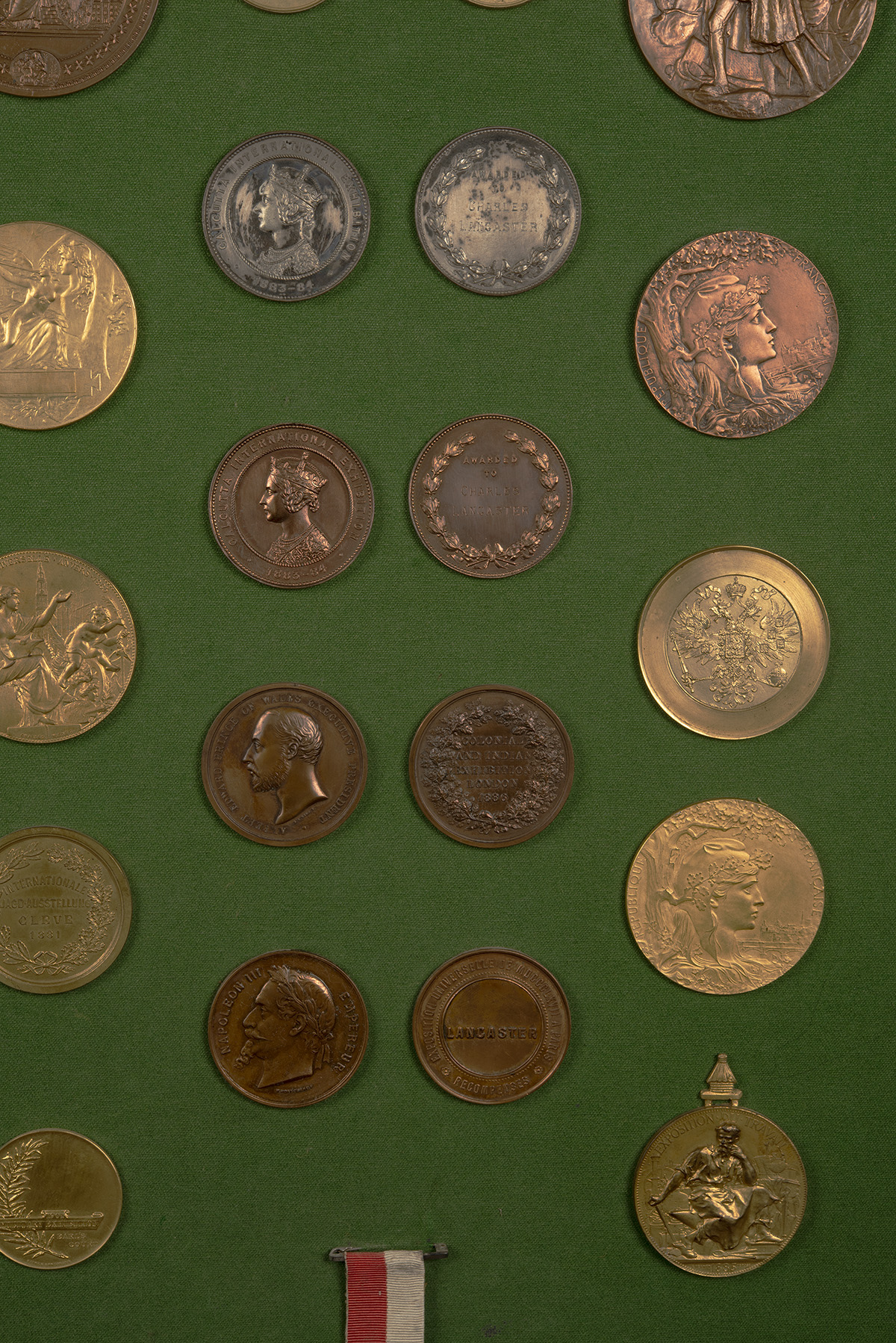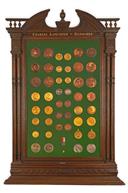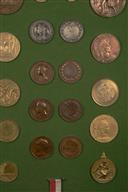Product Details
THE CHARLES LANCASTER MEDALS,
comprising twenty-six awards mainly for exhibitions, mounted against a green baize backing with a neo-classical oak frame, the top with 'CHARLES LANCASTER - GUNMAKER' in gilt lettering.
The medals are as follows:
Column 1
i. 3in. DIAM. BRONZE BY LEONARD G. WARD, 'Dissociata Locis Concordi Pace Ligavit', Royal Mint 1851, London.
Obverse: By W. Wyan, Royal Mint, 'Victoria D.G. Brit Reg. F.D. Albertus Princeps Conjux MDCCCLI'.
ii. 2 3/4in. DIAM. BRONZE BY J. TAUTENHAYN, 'Franz Joseph I. Kaiser von Oesterreich, Koenig von Boehmen etc, Apost Koenig von Urgarn'.
Obverse: 'Den Fortschritte', 'Weltausstellung 1873 Wien'.
iii. 3in. DIAM. BRONZE BY H. MITCHEL S.C., USA.
Obverse: 'International Exhibition Philadelphia MDCCCLXXVI', 'Awarded by United States Centennial Commission'.
iv. 63mm DIAM. GOLD BY L. BOTTEE, 'Exposition Universalle 1889'.
Obverse: 'Republique Francaise'.
v. 60mm DIAM. GOLD BY C.H. WIENER, BRUXELLES, 'Exposition Universelle Anvers 1885'.
Obverse: Leopold II Roi Des Belges Protecteur de l'Exposition'.
vi. 53mm DIAM. GOLD BY H. WECKWERTH, NURNBERG.
Obverse: 'Internationale Jagd-Ausstellung Cleve 1881'.
vii. 1 3/4in. DIAM. GOLD BY SPINK & SON, LONDON, '1901 Military Exhibition Earl's Court'.
Obverse: 'For Merit'.
viii. (left) 2 5/8in. DIAM. GOLD / SILVER, 'Prize of 1000 Rupees from H.H. Sir Jung Bahadur of Nepaul. 1873'.
viii. (right) 2 5/8in. DIAM. GOLD / SILVER, 'Complementary Annuity of 360 Rupees from H.H. The Maharajah of Joudhpoor. 1865'.
Column 2
i. 50mm DIAM. GOLD, 'Academie Nationale Agricole Manufacturiere et
Commerciale', 'Medaille Decernee a Charles Lancaster Londres'.
Obverse: 'Academie Nationale Agricole Manufacturiere et Commerciale', 'Fondee a Paris en 1850 Reconstituee en 1848'.
ii. 1 3/4in. DIAM. GOLD, '1885. International Inventions Exhibition', 'Invention', 'Music'.
Obverse: 'Victoria Regina'.
iii. 45mm DIAM. GOLD, 'Erste Wiener Internationale Ausstellung fur Velocipeds und Sportgegenstande. 1886'.
Obverse: 'Hochste Auszeichnung'.
iv. 2in. DIAM. SILVER, 'Calcutta International Exhibition. 1883-84'.
Obverse: 'Awarded to Charles Lancaster'.
v. 2in. DIAM. BRONZE, 'Calcutta International Exhibition. 1883-84'.
Obverse: 'Awarded to Charles Lancaster'.
vi. 2in. DIAM. BRONZE BY L.C. WYON F., 'Albert Edward Prince of Wales Executive President'.
Obverse: 'Colonial & Indian Exhibition London 1886'.
vii. 50mm DIAM. BRONZE BY H. PONSCARMEF, 'Napoleon III Empereur'.
Obverse: 'Exposition Universalle de MDCCCLXVII a Paris Recompenses', 'Lancaster'.
viii. 1 1/4in. DIAM. SILVER MEDAL ON RIBBON BEARING THE OTTOMAN COAT OF ARMS OF SULTAN ABDUL HAMID II.
Obverse: Arabic inscription.
ix. GOLD RING, 1/2in. DIAM. 'C / A B C D'.
Column 3
i. 3in. DIAM. BRONZE, 'Adelaide Jubilee International Exhibition. MDCCCLXXXVII'.
Obverse: 'First Order of Merit'.
ii. 3in. DIAM. BRONZE BY D. MACLISE R.A. DES., L.C. WYON FEC.
Obverse: '1862 Londini Honoris Causa'.
iii. 3in. DIAM. BRONZE BY C.E. BARBER, 'Christopher Columbus Oct-XII MCCCCXCII'.
Obverse: 'Worlds Columbian Exposition in Commemoration of the Four Hundredth Anniversary of the Landing of Columbus MDCCCXCII. MDCCCXCIII to Chas. Lancaster'.
iv. 64mm DIAM. BRONZE BY J.C. CHAPLAIN, 'Republique Francaise'.
Obverse: 'Exposition Universelle Internationale 1900'.
v. 60mm DIAM. GOLD, BEARING THE IMPERIAL RUSSIAN COAT OF ARMS.
Obverse: 'Praemia Digno Charles Lancaster 1868'.
vi. 64mm DIAM. GOLD BY J.C. CHAPLAIN, 'Republique Francaise'.
Obverse: 'Exposition Universelle Internationale 1900'.
vii. 55mm DIAM. GOLD BY F. VERNON, 'Exposition du Travail. 1885'.
Obverse: 'Decernee A'.
viii. 67mm DIAM. SILVER BY J.C. CHAPLAIN, 'Republique Francaise'.
Obverse: 'Exposition Universelle Internationale de 1878. Paris', 'Lancaster'.
Provenance: Previously sold through these rooms in 2008, we were kindly provided with the following provenance by David Baker:
Charles Lancaster (b. 1785) began his long career as a barrel maker, the first record dating from 1811 where he is noted as a "best gun barrel maker". His initials 'CL' are found on the barrels of guns of most of the London makers including John and Joseph Manton. Lancaster set himself up in business as a gunmaker in 1826 opening a shop at 151 New Bond Street where he quickly enjoyed the patronage of such illustrious sportsmen as Lieutenant Colonel Peter Hawker who made glowing reference to Lancaster in his book Instructions to Young Sportsmen, and Royal patronage including His Royal Highness Prince Albert. Lancaster died suddenly at the age of 61 in 1847. Between 1847 and 1854 the business was continued by Lancaster's eldest son Charles William who was later joined in 1855 by his younger brother Alfred where upon the business traded as Charles William & Alfred Lancaster. This partnership was dissolved in late 1859 and Charles William continued to trade at the 151 New Bond Street address until his death in 1878.
This group of awards is a tangible memento of the most innovative firm of London gunmakers from that heyday of gunmaking at the end of Queen Victoria's reign. While he traded as and, indeed, signed his letters "Charles Lancaster", the proprietor, Henry A.A. Thorn, had bought the business on the death of the founder's son. It was said of Mr. Thorn that he would have succeeded in any business. Certainly he brought to the firm a remarkable level of dynamism and organisation, which set him apart from his rivals.
His overall plan was to employ competent staff and leave to them the mundane day-to-day tasks of running the business, while he devoted himself to its promotion. In so doing, he has left us a fascinating legacy, not least his celebrity endorsement in the shape of letters from Annie Oakley, thanking him for his coaching her already very skilful shooting.
These medals were the trophies of one aspect of the promotional campaign. Industrial exhibitions were very much a part of the advertising landscape of the 19th Century. They ranged from small events in provincial centres to truly international gatherings in the great cities of the world. The Lancaster medals awarded at events held in Adelaide, Calcutta, Vienna, Paris, Philadelphia and London tell us much about the assiduity with which they were pursued.
The other year I had sight of a remarkable surviving piece of ephemera; the Lancaster "Descriptive Illustrated Pocket Catalogue", issued at The Universal Exhibition, held in St. Louis in 1904 and preserved for over a century by being kept in a gun case. Compressed into 36 pages, 6½" x 3¾", is a snapshot of Lancasters in 1904 but, from our present perspective, its interest lies in what we learn of Thorn's exhibition strategy. We look in vain for the "armes de luxe" - those totally impractical gunmaking tours de force had long been a feature of continental and indeed some London exhibitions. Instead we read:
"The weapons in this exhibit are similar to those generally manufactured, supplied and sold by this firm, and nothing has been specially made as an exhibition sample. This is highly to be commended, being an endeavour to obtain patronage from visiting Sportsmen on the actual article, so that purchasers can be certain of getting similar quality of weapons to those which are used by the leading Sportsmen, and which have, in many cases, stood the test of 30 years' hard work, a convincing proof of the excellence of the productions of the firm of Lancaster."
Significantly, orders were directed to an agent in New York and it would be of great interest to discover just how profitable the venture was because, from the prices printed in the catalogue, we see the effects of the U.S. tariffs. These, along with freight costs, practically doubled the price of a gun in the U.S.A. compared with London.
Perhaps this is why Mr. Thorn did not make the trip to St. Louis. Twenty years before, not withstanding the hazards, he had made the trip to Calcutta for the exhibition of 1883/4. Then the Indian princes were excellent customers for the London gun trade and so presumably the risks were considered acceptable. This time the medal was not the only award gained. Thorn also came home with a prize cricket bat, which was presented to him to mark the fact that he had the best average score of the Calcutta Exhibition Cricket Team of 1883/4. From this we gain a glimpse of the camaraderie that must have existed among the exhibitors.
These exhibitions were not the only source of medals, another decoration came from H.H. Sir Jung Bahadur of Nepaul in 1873. The citation with this claimed that his highness had no less than 250 rifles, but had found his Lancaster oval bore the most accurate. With the medal came a gift of 1,000 rupees and the citation ends with "kindly make me ten double barrel breech loading rifles with great care"!
In 1885, it appears that the firm presented the Sultan of Turkey with a specimen of their 4-barrel pistol as part of a wider promotional effort for this weapon. In return, the Sultan sent a medal, which became part of the Lancaster array as "Special Decoration from H.I.M. The Sultan of Turkey".
It has to be said that every last drop of kudos was extracted from these exhibition awards. Decades after the event, they were still flaunted in catalogues, advertising and indeed every piece of ephemera produced by the winners.
D.J. BAKER.
Literature: Don Masters, Atkin, Grant & Lang.
Other Notes: the Lot comes with two unmounted medallions: a second Calcutta International Exhibition 1883-84 two-piece medal, Bronze, 2in. diameter, the obverse with 'Awarded to CHARLES LANCASTER' and a white metal medallion, 2 1/2in. diameter, with 'AB & Cie.', 'ARGENT' mark (for Arthus Bertrand et Cie, est. 1911 in Paris), the obverse with 'CONCOURS DE FUSILS ET CARTOUCHES MONTE CARLO 1913' the reverse with 'MONTE-CARLO. SAISON 1913-14' in relief and a depiction of the Monaco Opera building
Please click HERE to view Terms & Conditions. Please note all Lots are listed in accordance with UK Law, for overseas buyers, please ensure you are familiar with your relevant local firearms and customs regulations before bidding.
Estimate £5,000-7,000







